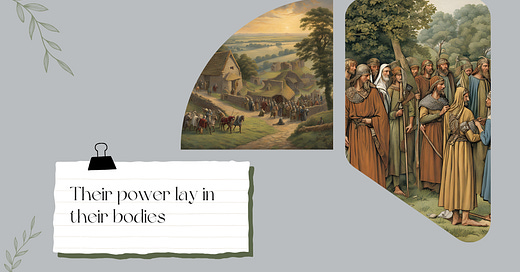Their power lay in their bodies
Uncovering the stories of medieval women needed by men for political survival
This post explores the practice of exogamy, where individuals travelled outside their native land to marry, often for political reasons. It focuses on women in the seventh century, a time that was really quite unique and special for women (see more on this in my International Women’s Day post - click here!). I suggest here that we should see these women as vessels of power rather than victims of male politics, as their marriages provided something that the men needed in order to survive, or even thrive, in their roles as political leaders.
What do we think of when we say arranged marriage?
I’d hazard a guess that it’s usually the narrative of a woman with little to no agency being forced into a lifelong relationship with someone she barely knows, wouldn’t choose for herself, and is significantly younger than. Usually for religious or political reasons.
This kind of arranged marriage certainly happened in the past and continues to happen today.
Sadly, the individuals at the top of the medieval political sphere rarely had a say in who they married: for princes and princesses at least, this would have been arranged by their parents during early childhood. Already by the seventh century, English aristocratic families were connected by ties of marriage across kingdoms and islands.
I wonder if we feel the injustice of this situation because we live in a time and place where most of us marry, if we marry, for love.
But what if these women were actually vessels of power?
These women represented something that men wanted, needed, and couldn’t get without them.
Simply by existing, they held power in their bodies:
Power to secure a fledgling dynasty with political alliance, helpful in times of war and uncertainty
Power to elevate a regional kingdom to a broader European stage
Power to add prestige to an emerging family
The men they married might not have thought of their wives in this way: they more likely thought of them as a means to connect with other powerful men, their fathers and brothers.
But it was the women, through their marriages, that forged these connections.
This happened across the social scale of seventh-century England.
There are women whose names we know.
Queen Bertha, the protagonist of our serialised novel Bertha’s Tale (click here to read all instalments!) came to Kent from Francia, a member of the Frankish royal family.
Her daughter, Æthelburh, travelled from Kent to Northumbria (at that point a separate kingdom, so much like a different country would feel today) to marry their king, Edwin.
Bertha’s sister in law, Ricule, was mother of the East Saxon king Sæberht, indicating that she too had married into the royal family of a separate kingdom.
These three women alone connected four kingdoms that would otherwise have remained separate if it were just up to the men.
And there are women whose names have been lost to us - but their bodies have not. And what a story they tell!
Emma Brownlee, an archaeologist working on early medieval burials, recently wrote on the phenomenon of bed burials. These are, essentially, a series of female burials where the bodies seem to have been laid, very carefully, on a bed within the grave.
This is an extremely restricted rite in England: very few examples are known, and these examples sit within an already-socially-restricted rite of lavish seventh-century female burial (I wrote more about that in my International Women’s Day post - click here to read it).
What’s really interesting about these burials is that they only otherwise occur in very specific regions on the Continent. Brownlee suggests that their appearance in England is linked to exogamy, the practice of travelling to marry.
These burials, therefore, could be the remains of women who were sent far from their homeland to marry men that needed something only connecting to them could bring. They were buried on their beds as their mothers, sisters, and grandmothers had been.
Why does this matter?
Acknowledging the power these women held in their bodies, I think, restores value, dignity and worth to individuals who otherwise had very little agency.
It gives them a position right at the centre of political events, whether they were ever involved in high-level discussions and decision-making or not, because their marriages were a political act that could not have taken place without them.
They were needed by men, and while their lives were so much more than the value they provided to their husbands, I think that viewing them in this way starts to change the narrative around medieval women ever so slightly.
What do you think?
Leave a comment to continue the conversation below!
If you haven’t already, hit subscribe to receive future biographies and more (short stories, poetry discussions, book reviews, and instalments of my serialised novel), straight to your email inbox (or Substack app, if you prefer to read at leisure like me!).
Are you new around here? Check out this introductory post to find out more about what we do here at Telling Their Tales.
Telling Their Tales - What's it all about?
Hi there, I’m Holly. Welcome! I’m currently a full-time stay-at-home-mum, having welcomed our little one in May 2023, and I pursue my love for reading and writing history in the edges of motherhood (read: during nap times). Motherhood has changed me entirely in more ways than I have words to describe here, but one of the best is that I’ve been able to sp…







Nice work! ☺️I really enjoyed your refreshing view on the women as powerful and needed by men, rather than the tired story of their victimization.
An interesting piece, Holly, as is your International Women's Day one. There will be so many influential women that we don't know of because they aren't in the written records, or burial practices don't suggest them as someone of importance.